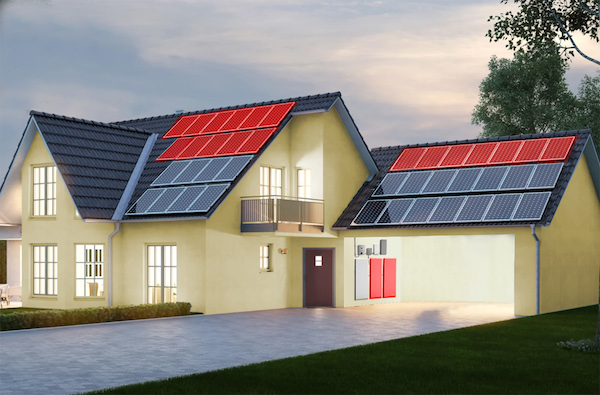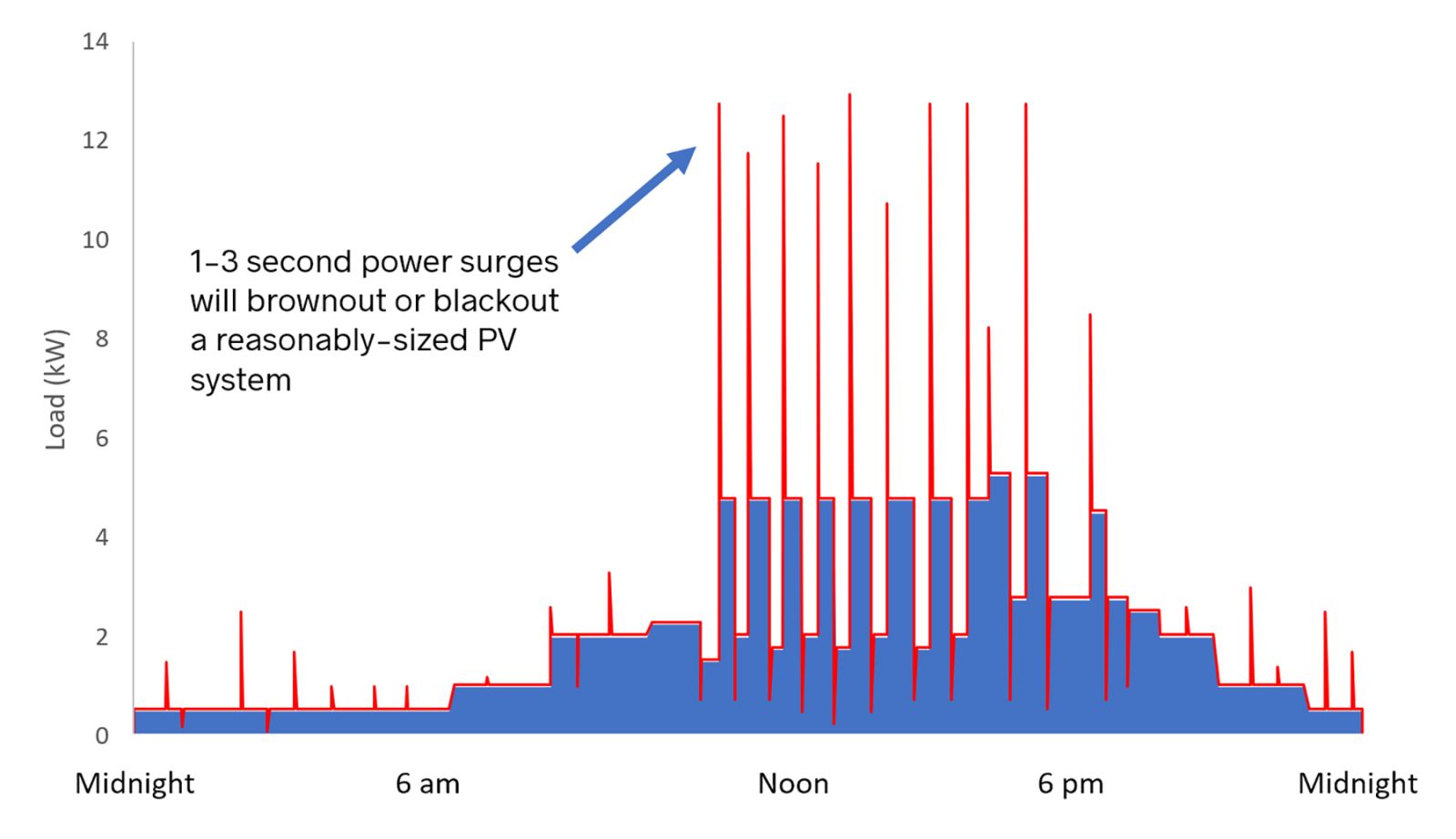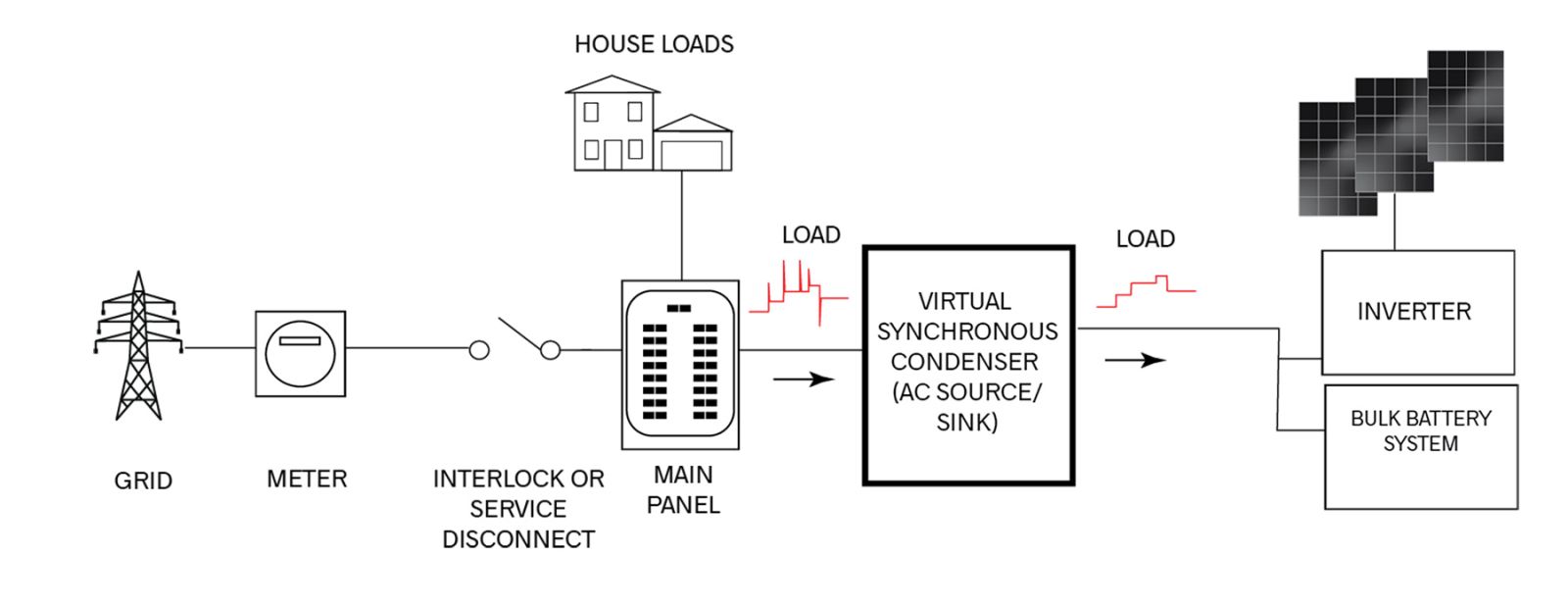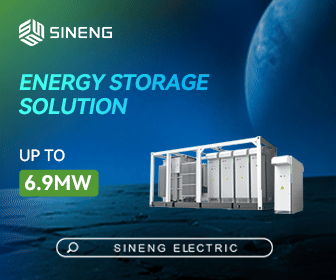A Smarter Path to Whole House Backup Power
Whole house backup power is on everyone’s minds these days. In the past several years, the US has experienced an unprecedented number of long-term power outages, with storms disrupting services to millions of customers for weeks (or, in the case of Puerto Rico, months). In California, millions risk losing power every fall when utilities employ rotating power outages to mitigate wildfire risk.

A home with a typical PV and battery backup system. The panels and batteries shown in red indicate the excess equipment that is required to handle surge loads during a power outage. When the grid is up, this excess capacity sits idle, benefiting neither the homeowner nor the grid operator.
Solar plus storage is a sound investment—at the right size
For on-grid use, a 6–8 kW, grid-tied PV array with a 5–10 kWh bulk battery system can be a cost-effective investment. The battery system stores excess daytime PV capacity for load shifting, saving the homeowner money by offsetting evening grid power use (when the rates are typically higher). This ability to shift load times is also a critical asset for utilities, helping to balance supply-demand.
Oversized bulk batteries unbalance the equation
A system this size is also often sufficient to cover whole-house average loads during a power outage. The challenge, of course, is that covering average loads is only part of the job.
To run reliably during an outage, a PV system needs AC voltage stabilization, load management, and, most importantly, surge power capacity. When air conditioners, refrigerators, and other large household appliances start up, they momentarily (1–3 seconds) pull 2-3 times their average load. These “surge loads” are normally absorbed by the grid, but during an outage they must be handled by the PV/backup system.
Figure 1 shows the power requirements of a typical home running air conditioning from 11 am to 5 pm. On a sunny California or Florida summer day, a 6 kW PV array with a 9-kWh backup battery system would be able to generate and store enough energy to cover all the power requirements for this house. However, commercially-available backup battery systems in this size range typically can only handle 3.5–6 kW of nominal power, and 4.5–10 kW of surge. Therefore, even if the battery backup system can handle the maximum nominal loads (around 5 kW), the surge loads—when the AC unit turns on, for example—would quickly brownout, or blackout, the system.

FIGURE 1. Typical power profile of home wih a whole-house AC system. While the nominal load is always less than 6 kW, the momentary surge loads exceed 12 kW, well above the capacity of a standard 9-14 kWh bulk battery system.
The problem is that the conventional approach for whole-house PV backup power uses PV panels plus bulk storage batteries to handle both average and surge power requirements. Even though the surge loads only last a few seconds (and have a negligible effect on the home’s overall power usage), it’s not unusual for a residential system to balloon to a 10+ kW PV array and 20–30 kWh of battery capacity just to cover the surge loads during a power outage. When the grid is up, this excess capacity benefits neither the homeowner nor grid operator. Critically, it also can add up to $30,000 to a PV system’s price—too high for most homeowners. This is a primary reason why only 5 percent of the 3 million solar powered homes in the US can operate during a grid outage.
Using bulk batteries for surge is hard on the environment, and the batteries
Lithium-ion batteries, the most common type used for bulk storage batteries, are optimized for stable loads, and perform very well in this role. Repeated surge loads can dramatically shorten the lifespan of the batteries, risking expensive replacement and difficult disposal. No matter what sized battery system is available, from a 5-kWh bulk battery to a 50-kWh EV, the batteries need to be shielded from the surge loads to protect their lifespan.
Lithium-ion batteries also present a host of environmental and humanitarian issues. This finite natural resource is projected to be depleted within the next 20 years, so equipping homes with kilowatt-hours of batteries that sit unused for 360+ days of the year is imprudent at best.
A much more effective solution for backup power, then, would be to use bulk batteries solely to store excess daytime energy to cover nominal energy loads, and to employ an alternative technology for surge power.
Alternatives for surge power
Power plants have been using synchronous condensers for over 100 years to absorb or generate real and reactive power to stabilize the grid. Industrial synchronous condensers typically employ massive, free-spinning DC motors to generate kinetic energy to provide voltage stabilization.
A similar approach can be used on a residential scale with a “virtual synchronous condenser” (VSC). The VSC provides AC stabilization, load management, and surge capacity to allow a standard, grid-tied PV system to power a home through an outage. The VSC includes a lead-acid battery, or small bank of supercapacitors, to provide the surge capacity (typically 5–10 kW). A critical feature of the VSC approach is that the surge power it provides is in addition to that produced by the PV panels, so even a small PV system can continue to function during a power outage.
For households with infrequent power outages, a virtual synchronous condenser outfitted with a lead-acid battery is an economical solution for handling surge power. A VSC with a single car starter battery can provide 5 kW of capacity, which, coupled with a 6 kW PV system, would be able to handle surge loads up to 11 kW. Like lithium-ion batteries, the lead-acid batteries will degrade when subjected to surge loads. However, lead-acid batteries have the advantages of being abundantly available, readily recyclable, and relatively inexpensive.
Additionally, for homeowners or business owners on a budget who don’t need overnight power and just want to keep their PV systems working during daylight hours during a power outage, a VSC system can be used to power a home without a bulk battery system altogether. This has the potential to provide life-saving emergency power to millions of homeowners for whom even a small bulk battery system is too expensive.
For households that experience frequent power outages, or off grid homes, a VSC outfitted with supercapacitors could be the most economical solution. While the upfront costs of supercapacitors are high, they are specifically designed for handling the voltage spikes generated from surge loads with minimal degradation.
Assuming the use cycle shown in Figure 1, the PV system would experience 15–20 surge “cycles” each day. If we assume each of these cycles produces the degradation equivalent to starting a car, we can estimate the cost in battery degradation when using an automotive battery for the surge loads to be under $1/day. For the supercapacitors, the cost would to around $0.25/day. Good characterization data on the damage to a Lithium-Ion battery from voltage surges is hard to find, but assuming degradation similar to the lead-acid batteries suggests that the costs to use a Lithium-Ion bulk storage battery system to cover surge loads could be $20/day or more.
Figure 2 shows the deployment of a VSC with a bulk battery and inverter system. The VSC absorbs the surge loads, effectively shielding the bulk batteries from these spikes. The VSC can also be integrated as a module, with the inverter in the bulk battery system.


FIGURE 2. Electronic controls can pull surge power from a supercapacitor or lead-acid batteries while shielding bulk batteries from potentially damaging spikes.
The VSC approach has many advantages over the status quo. It could save homeowners up to $30,000 in up-front costs on their backup PV power system. It protects the homeowner’s investments in bulk and EV batteries by shielding the batteries from damage when they are used during a power outage. It also allows middle income homeowners with small PV systems to cost-effectively add day-time PV backup power.
Widespread adoption of the VSC approach has the potential to spur residential PV investment by allowing backup PV power at an affordable cost. Furthermore, California’s worsening duck curve led to the California Energy Commission’s recent decision to greatly curtail net metering for new PV systems—in part to drive more homeowners to install batteries and off-load evening power demand. An economically-sound battery backup system would incentivize customers to install right-sized battery systems that help the consumer, the utilities, and the environment.
 Kirsten Pace is co-founder and COO of Maxout Renewables, and co-inventor of the VSC technology behind Maxout's Evergrid modular and standalone solutions for affordable PV backup power. Maxout Renewables, a 2020 winner of the American Made Solar Prize, is developing power electronics to improve the affordability and resilience of residential PV systems. Kirsten can be reached at [email protected]
Kirsten Pace is co-founder and COO of Maxout Renewables, and co-inventor of the VSC technology behind Maxout's Evergrid modular and standalone solutions for affordable PV backup power. Maxout Renewables, a 2020 winner of the American Made Solar Prize, is developing power electronics to improve the affordability and resilience of residential PV systems. Kirsten can be reached at [email protected]
Maxout Renewables | www.maxoutrenewables.com
“Visit us at RE+ in Las Vegas, booth #18023"
Author: Kirsten Pace









